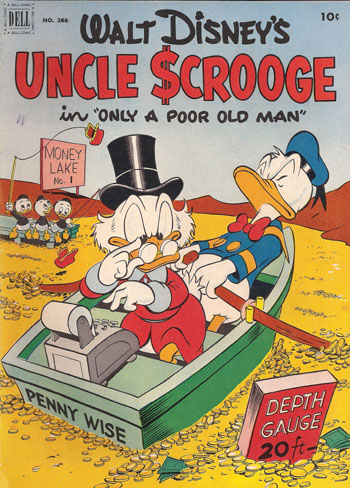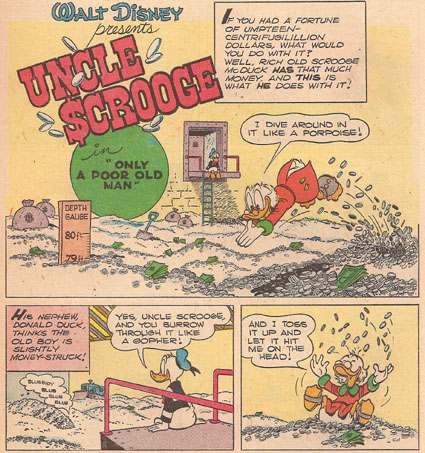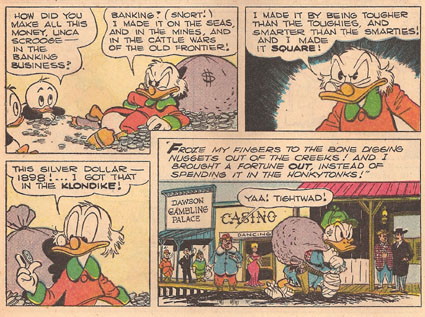
ESSAYS
[This piece was submitted—and rejected—as an entry in the Wall Street Journal's series titled "Masterpiece," weekly essays on outstanding works of art, music, architecture, and literature. Comic books do not qualify, alas.]
The World’s Richest Duck
By Michael Barrier
 Before the rise of graphic novels like Art Spiegelman’s Maus late in the last century, comic books were an artistic slum. Only rarely, as with the Mad of the early 1950s, did comic books win even the slightest nod from outside the ranks of their regular readers (who were usually children, plus some adults who read nothing else). Almost invariably, anyone who wrote about comic books in a mainstream publication did so to condemn them. But there were exceptions.
Before the rise of graphic novels like Art Spiegelman’s Maus late in the last century, comic books were an artistic slum. Only rarely, as with the Mad of the early 1950s, did comic books win even the slightest nod from outside the ranks of their regular readers (who were usually children, plus some adults who read nothing else). Almost invariably, anyone who wrote about comic books in a mainstream publication did so to condemn them. But there were exceptions.
The anti-comics din was loudest around the time the novelist Charles Beaumont wrote a piece for the May 1955 issue of a California magazine called Fortnight. Beaumont had visited the Beverly Hills offices of Whitman Publishing Co., which produced comic books published under the Dell label. Whitman was then the colossus of the comic-book world, with sales of around 300 million copies a year. Most of its comics were based on animated-cartoon characters like Donald Duck and Bugs Bunny, or television cowboys like Roy Rogers and Gene Autry. Beaumont’s article focused on how industriously Whitman’s editors scrubbed from their comic books anything that might conceivably offend an anxious parent. He paused, though, to acknowledge the special status of one of Whitman’s artist-writers, Carl Barks, whose work had “a freshness and originality which both inspire and depress colleagues.”
Barks, who was in his mid-fifties, had been working for Whitman as a free-lancer for thirteen years. He had come there from the Disney studio, where he was one of the writers for the Donald Duck cartoons. After growing up on an isolated ranch in southern Oregon, he had suffered through a succession of grueling jobs—heating rivets in a railroad repair shop, for example—before finding a way out through cartooning. He drew magazine gag cartoons at first, then got a job at Disney’s.
At Whitman, Barks’s core assignment was writing and drawing a ten-page Donald Duck story that opened each monthly issue of Walt Disney’s Comics & Stories. That story may well have been what Beaumont called it, “the best-loved story in the comic world,” since Walt Disney’s Comics had a circulation of around 3 million copies per issue. Barks had also contributed longer stories with Donald Duck to other Whitman comic books, and he was writing and drawing a new quarterly title starring a character he invented, Donald’s fabulously rich Uncle Scrooge McDuck.
Beaumont wrote of Uncle Scrooge’s “popularity among the ‘intelligentsia,’” and of the “flood of fan mail” that Barks’s stories evoked, especially the complaints when other cartoonists filled in on the monthly Donald Duck stories. Barks himself never saw such evidence of his stories’ popularity. Like other Whitman artists, he was not allowed to sign his work—only Walt Disney’s name appeared on it—and his admirers knew him only as “the good artist.” He lived in a desert town many miles east of Beverly Hills, and rarely visited Whitman’s offices. If he wanted to see his stories in print, he bought his own copies of the comic books at a newsstand. He was paid at page rates that did not reflect the popularity of his stories.
Barks’s stories owed their “freshness and originality” solely to the stimulation he found in his assignments from Whitman. Like only a few other comic-book workers—including some of his Whitman colleagues—Barks found an odd sort of artistic freedom in working for an audience made up mostly of prepubescent children. Young children’s demands are rigorous, but artists whose temperaments permit them to meet those demands can find themselves liberated to explore vast reaches of human behavior. So it has always been with the authors of great children’s books, and so it was with Barks, who gave his characters adult motivations but depicted them in terms children could understand.
 That was especially true of Uncle Scrooge. He first appeared in 1947, in one of Barks’s longer Donald Duck stories, as a grumpy, hunched old miser with a name borrowed from Dickens. Scrooge’s great virtue, from a comic-book writer’s point of view, was that his wealth opened up story possibilities—it could transport the ducks to exotic locales, like an ancient castle in Scotland or the North African desert, with minimal preliminaries. As Scrooge took part in such comic adventures, he inevitably became more active and youthful.
That was especially true of Uncle Scrooge. He first appeared in 1947, in one of Barks’s longer Donald Duck stories, as a grumpy, hunched old miser with a name borrowed from Dickens. Scrooge’s great virtue, from a comic-book writer’s point of view, was that his wealth opened up story possibilities—it could transport the ducks to exotic locales, like an ancient castle in Scotland or the North African desert, with minimal preliminaries. As Scrooge took part in such comic adventures, he inevitably became more active and youthful.
He also became more conspicuously a businessman, inviting comparisons less with Silas Marner (or Ebenezer Scrooge) than with the robber barons of the nineteenth century. Barks’ direct inspiration for the character was Andy Gump’s Uncle Bim, an Australian billionaire in Sidney Smith’s comic strip “The Gumps.” Bim’s wealth was a catalyst for Smith’s stories in the early 1930s, just as Scrooge’s wealth would be for Barks twenty years later. “The Gumps” was domestic drama, though, and Bim a warm and admirable character. In Barks’s early stories with Scrooge, the old duck was usually greedy and arrogant, incredibly tightfisted except when the status of his huge fortune—with which he identified completely—was somehow called into question.
What made Scrooge’s egomaniacal rapacity funny, rather than alarming, was its expression through wildly comic episodes. In one story, Scrooge and Donald battle each other furiously—and destructively—at the controls of two steam shovels; when they are fined a million dollars in night court, Scrooge contemptuously tosses two million over his shoulder at the judge. In another story, he competes with an Indian maharajah to see who can build the largest statue of a pioneer called Cornelius Coot; the resulting statues are so huge they would have stunned the pharaohs, and they bankrupt the maharajah (but not Scrooge, of course).
So colorful a character was irresistible to children, and by the fall of 1951 the sales of the Disney comic books with Scrooge had risen to the point that Barks’s editors asked him to write and draw a “one-shot” comic book starring that character; it would test the market for a regular series.
Barks immediately had a problem. Scrooge had been a perfect foil for Donald Duck and his three nephews. The question now was how to put him into a leading role without fatally diluting what had made him attractive as a supporting player. In “Only a Poor Old Man,” the 32-page story that filled the first issue of Uncle Scrooge, Barks softened his character a bit, by taming his greed. Most important, though, he gave Scrooge’s attachment to his fortune an emotional basis, by emphasizing how he’d acquired it. In doing so, Barks made Scrooge more complex and interesting than before, without sacrificing what had made him funny and appealing. There are dozens of Barks stories in which he demonstrated his mastery of his medium, but “Only a Poor Old Man” may be the one where that mastery is most clearly visible.
 In earlier stories, Barks had casually identified Scrooge as a “financier” or the owner of a “mortgage business,” but now the ornery old duck spoke of prospecting for copper in 1882 and taking gold out of the Klondike in 1898. Scrooge scorned the idea that he might have made his money through banking or some other sedentary pursuit. "I made it on the seas, and in the mines, and in the cattle wars of the old frontier,” he told Donald’s nephews. “I made it by being tougher than the toughies, and smarter than the smarties. And I made it square. ... You'd love your money, too, boys, if you got it the way I did—by thinking a little harder than the other guy—by jumping a little quicker—”
In earlier stories, Barks had casually identified Scrooge as a “financier” or the owner of a “mortgage business,” but now the ornery old duck spoke of prospecting for copper in 1882 and taking gold out of the Klondike in 1898. Scrooge scorned the idea that he might have made his money through banking or some other sedentary pursuit. "I made it on the seas, and in the mines, and in the cattle wars of the old frontier,” he told Donald’s nephews. “I made it by being tougher than the toughies, and smarter than the smarties. And I made it square. ... You'd love your money, too, boys, if you got it the way I did—by thinking a little harder than the other guy—by jumping a little quicker—”
As Barks put it in a 1974 interview, “He had lots of money, but he wasn’t a criminal about it.”Of course, a real billionaire who had made himself rich from Montana copper wouldn’t have plunged into the gold fields alone 16 years later. There may be echoes of Andrew Carnegie in Scrooge’s Scottish surname, but the real Carnegie, unlike the fictional duck, hired other people to do such work for him as soon as he could. What Barks was doing, with his young audience in mind and with remarkable thoroughness and ingenuity, was making the reasons for Scrooge’s attachment to his wealth as concrete as possible. If Scrooge carried gold out of the Klondike himself, then of course he’d care about it.
Barks made Scrooge’s fortune concrete, too. For children, money is cash—rare is the child who grasps that money can be something other than bills and coins—and as early as 1949, Scrooge’s desk was awash in the stuff. In a story published shortly before “Only a Poor Old Man,” Barks went further, so that Scrooge’s wealth was not only measured in cubic acres but actually filled a huge cube, which he called his “money bin.” Scrooge had the kind of fantastic wealth a child could understand, and he hoarded that money in what amounted to a gigantic piggy bank.
A child with a lot of cash might want to spend it on toys, but for Scrooge, his money itself was an enormous toy. As Barks reshaped his character, a sense of play joined the acquisitive urge as one of Scrooge’s dominant characteristics.
At the end of "Only a Poor Old Man," after the ducks have fended off a determined criminal effort to drain the money bin, Donald tells Scrooge, "You may not know it, Uncle Scrooge, but your billions are a pain in the neck. You're only a poor old man!" Scrooge stares bleakly after Donald, but then declares defiantly: "Bah! Kid talk! No man is poor who can do what he likes to do once in a while!" And what Scrooge likes to do—and does as the story ends—is play in his money: he dives around in it like a porpoise, burrows through it like a gopher, and tosses it up and lets it fall on his head.
Scrooge's adversaries in “Only a Poor Old Man” (as in many later stories) are a family gang called the Beagle Boys, dog-faced criminals who dress alike—domino masks, sweatshirts inscribed “Beagle Boys, Inc.”—and go by prison numbers instead of names. They are the anti-Scrooge: bureaucratic criminals who represent all the large organizations—thus their “Inc.”—dedicated to imposing uniformity on prickly individualists. The Beagles care about Scrooge’s money only as money, not as the source of the pleasure he takes in it, and the money itself takes a sort of revenge on them. At the climactic moment, when they seem to have won, they cannot resist following his example and diving as a group into his cash. Unlike Scrooge, they smash themselves unconscious against all that metal. In Carl Barks’s comic-book world, it’s the bureaucrats who lose and the individualists who win—and there’s no doubting the outcome, because everything about that world is so solid and real.
“Only a Poor Old Man” made Scrooge a comic-book star. Whitman began publishing Uncle Scrooge on a quarterly schedule in 1953. With sales of well above a million copies per issue, it was one of the comic-book industry’s bright spots in the 1950s. Barks himself remained anonymous, despite Beaumont’s 1955 article. It was only in the early 1960s that his name began to spread among curious fans. He retired from Uncle Scrooge in 1966, and in later decades (he died in 2000, at the age of 99) he devoted himself mainly to oil paintings of the ducks he had drawn so often for comic books.
Barks’s Scrooge stories have been reprinted constantly since he retired, and they still enjoy an enthusiastic following, especially in Europe. Currently, all his stories with the Disney ducks are being reprinted in Scandinavia in deluxe boxed sets. One of his oil paintings sold recently at auction for $202,000.
It was only in his later years, as through the sales of paintings, that Barks reaped some financial rewards from his popularity. Over his years as a comic-book worker, he occasionally contemplated breaking away, as with a comic strip of his own, but he always wound up sticking with Whitman. In Barks’s stories, Uncle Scrooge is recognizably entrepreneurial—for one thing, he finds it very hard to delegate—but Barks himself lacked entrepreneurial drive. He blamed that lack only on himself. “The economic system is such that a guy that has any ability can make something of that ability,” he said in 1974, “and I just didn’t have the ability, so I was where I was. I accepted that, and that was it.”
[Posted February 15, 2008; prefatory note added July 10, 2008]